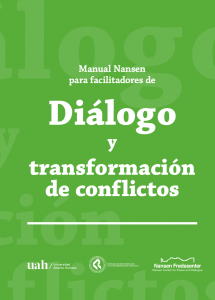
One of the most important universities in Chile has been responsible for the translation and publication of the NCPD´s handbook into Spanish.
Hundreds of people in Chile have received dialogue training over the past year. The work is now being strengthened by the publication of the Nansen Center for Peace and Dialogue (NCPD) handbook in Spanish. The Ministry of Foreign Affairs in Norway has supported the project.
«We at the Nansen Center are happy and proud of this translation. We hope and believe that the handbook will benefit many people, not only in Chile but also in other Spanish-speaking countries», says Alfredo Zamudio, Director of NCPD.
The handbook will be available free of charge throughout the Spanish-speaking world. The Rectoral Council of 30 Chilean universities, the Consejo de Rectores de las Universidades Chilenas (CRUCH), is involved in the project and contributes to reaching many people.
«We are proud that such a solid body stands behind the handbook. In addition, the principals have asked to join the course as soon as possible. They begin this month», says Zamudio.
The Alberto Hurtado University in the capital Santiago has been responsible for all the practicalities – a collaboration that has been of particular importance to the Spanish translation.
Listening to what is bubbling beneath the surface

«The purpose of the handbook is to show that it is possible to change the form and expression of conflicts. We try to get the participants to see that dialogue is a tool that can contribute to considerably more solid solutions than what is achieved with negotiations. Many people get an eye opener when they start learning about dialogue, when they feel how difficult it is to listen thoroughly first, and not start negotiating», Zamudio explains.
The NCPD handbook presents exercises that help to understand what lies behind conflicts – including an understanding of what prevents societies in crisis from listening in time to what is bubbling beneath the surface.
Restore trust
Zamudio has led several different dialogue activities in Chile over the past year. He explains that in conflicts, negotiation, mediation or dialogue is usually employed. When there is no trust between the parties, dialogue is often the first step. In such a process, dialogue is not about accepting injustice or abuse – talking to “the other” is not the same as giving up ideals or rights. Dialogue in conflicts is often about creating space for meetings, and then seeing what happens.
The handbook is written by Norunn Grande and Christiane Seehausen at NCPD, and Tatjana Popovic from the Nansen Dialogue Center in Serbia. The «Nansen Handbook for Trainers in Dialogue and Conflict Transformation» has previously been translated into Polish and Dari – for use in Afghanistan.

Text: Kai Nygaard. Published 14th of October 2020
Nansen Center for Peace and Dialogue (NCPD) is a knowledge center and meeting point for dialogue and conflict transformation. The center conducts peace and dialogue work both in Norway and internationally, and has experience from Western Balkans, Afghanistan, Iraq, Poland, and more. In Norway, NCPD guides schools and municipalities in conflict transformation, and teaches and facilitates dialogue. NCPD promotes peace, human rights, dialogue and reconciliation through training courses, documentation and sharing knowledge based on field experiences. NCPD is located at the Nansen Academy in Lillehammer, Norway.